英汉翻译绪论
- 格式:ppt
- 大小:234.00 KB
- 文档页数:18
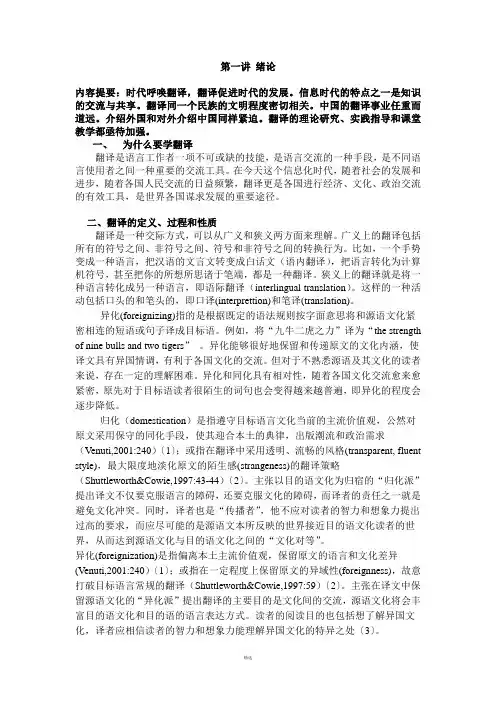
第一讲绪论内容提要:时代呼唤翻译,翻译促进时代的发展。
信息时代的特点之一是知识的交流与共享。
翻译同一个民族的文明程度密切相关。
中国的翻译事业任重而道远。
介绍外国和对外介绍中国同样紧迫。
翻译的理论研究、实践指导和课堂教学都亟待加强。
一、为什么要学翻译翻译是语言工作者一项不可或缺的技能,是语言交流的一种手段,是不同语言使用者之间一种重要的交流工具。
在今天这个信息化时代,随着社会的发展和进步,随着各国人民交流的日益频繁,翻译更是各国进行经济、文化、政治交流的有效工具,是世界各国谋求发展的重要途径。
二、翻译的定义、过程和性质翻译是一种交际方式,可以从广义和狭义两方面来理解。
广义上的翻译包括所有的符号之间、非符号之间、符号和非符号之间的转换行为。
比如,一个手势变成一种语言,把汉语的文言文转变成白话文(语内翻译),把语言转化为计算机符号,甚至把你的所想所思诸于笔端,都是一种翻译。
狭义上的翻译就是将一种语言转化成另一种语言,即语际翻译(interlingual translation)。
这样的一种活动包括口头的和笔头的,即口译(interprettion)和笔译(translation)。
异化(foreignizing)指的是根据既定的语法规则按字面意思将和源语文化紧密相连的短语或句子译成目标语。
例如,将“九牛二虎之力”译为“the strength of nine bulls and two tigers”。
异化能够很好地保留和传递原文的文化内涵,使译文具有异国情调,有利于各国文化的交流。
但对于不熟悉源语及其文化的读者来说,存在一定的理解困难。
异化和同化具有相对性,随着各国文化交流愈来愈紧密,原先对于目标语读者很陌生的词句也会变得越来越普遍,即异化的程度会逐步降低。
归化(domestication)是指遵守目标语言文化当前的主流价值观,公然对原文采用保守的同化手段,使其迎合本土的典律,出版潮流和政治需求(Venuti,2001:240)〔1〕;或指在翻译中采用透明、流畅的风格(transparent, fluent style),最大限度地淡化原文的陌生感(strangeness)的翻译策略(Shuttleworth&Cowie,1997:43-44)〔2〕。
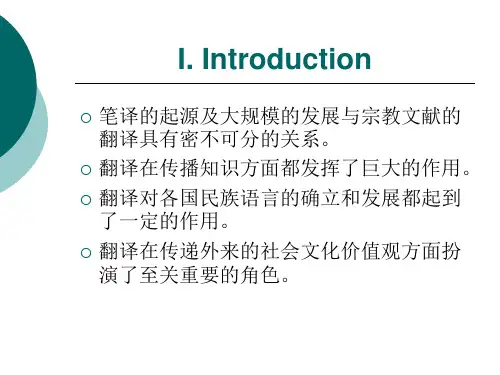
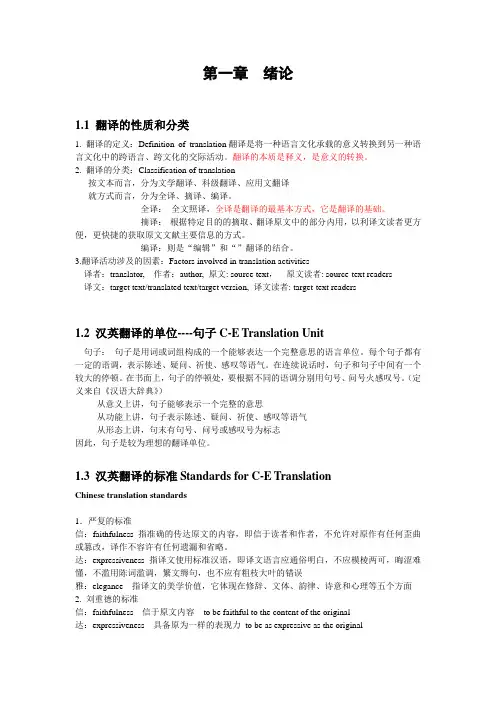
第一章绪论1.1 翻译的性质和分类1. 翻译的定义:Definition of translation翻译是将一种语言文化承载的意义转换到另一种语言文化中的跨语言、跨文化的交际活动。
翻译的本质是释义,是意义的转换。
2. 翻译的分类:Classification of translation按文本而言,分为文学翻译、科级翻译、应用文翻译就方式而言,分为全译、摘译、编译。
全译:全文照译,全译是翻译的最基本方式,它是翻译的基础。
摘译:根据特定目的的摘取、翻译原文中的部分内用,以利译文读者更方便,更快捷的获取原文文献主要信息的方式。
编译:则是“编辑”和“”翻译的结合。
3.翻译活动涉及的因素:Factors involved in translation activities译者:translator, 作者:author, 原文: source text,原文读者: source-text readers译文:target text/translated text/target version, 译文读者: target-text readers1.2 汉英翻译的单位----句子C-E Translation Unit句子:句子是用词或词组构成的一个能够表达一个完整意思的语言单位。
每个句子都有一定的语调,表示陈述、疑问、祈使、感叹等语气。
在连续说话时,句子和句子中间有一个较大的停顿。
在书面上,句子的停顿处,要根据不同的语调分别用句号、问号火感叹号。
(定义来自《汉语大辞典》)从意义上讲,句子能够表示一个完整的意思从功能上讲,句子表示陈述、疑问、祈使、感叹等语气从形态上讲,句末有句号、问号或感叹号为标志因此,句子是较为理想的翻译单位。
1.3 汉英翻译的标准Standards for C-E TranslationChinese translation standards1.严复的标准信:faithfulness 指准确的传达原文的内容,即信于读者和作者,不允许对原作有任何歪曲或篡改,译作不容许有任何遗漏和省略。
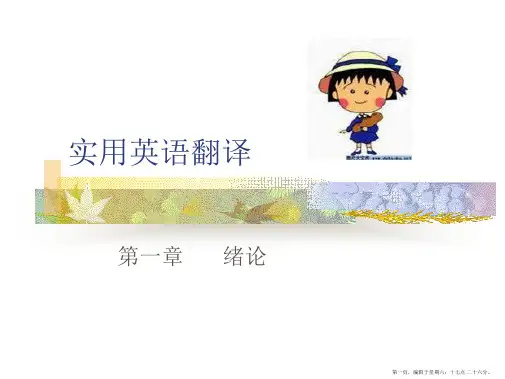
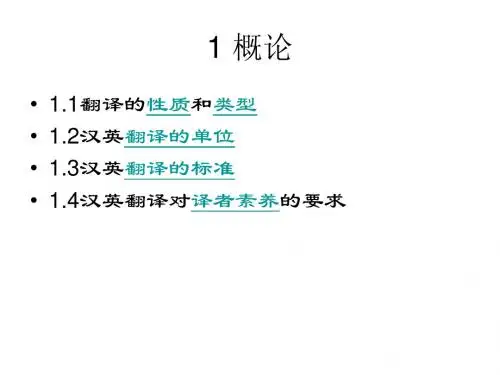
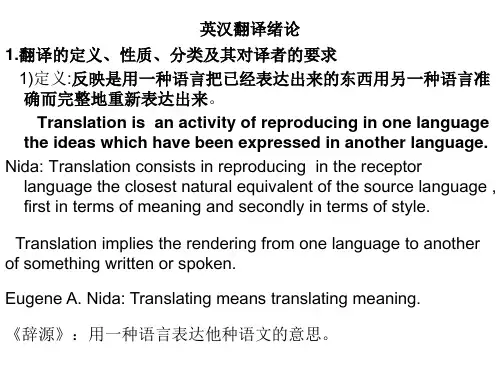
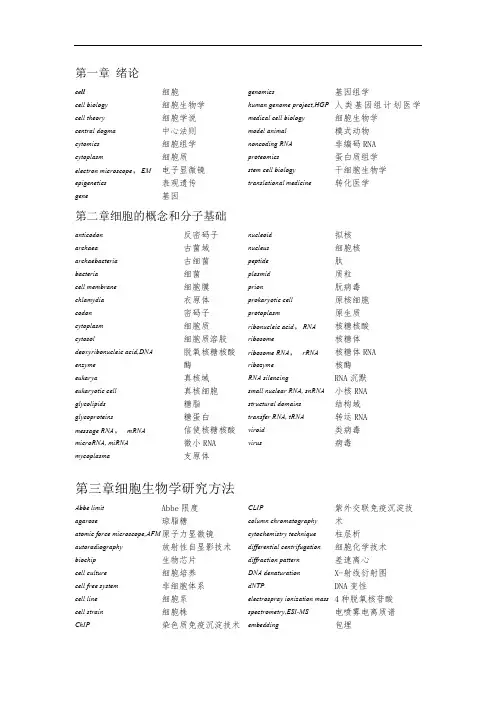
第一章 绪论cellcell biology cell theory central dogma cytomics cytoplasmelectron microscope ,EM epigenetics gene细胞细胞生物学 细胞学说 中心法则 细胞组学 细胞质 电子显微镜 表观遗传 基因genomicshuman genome project,HGP medical cell biology model animal noncoding RNA proteomics stem cell biology translational medicine基因组学人类基因组计划医学细胞生物学 模式动物 非编码RNA 蛋白质组学 干细胞生物学 转化医学第二章细胞的概念和分子基础anticodon archaea archaebacteria bacteria cell membrane chlamydia codon cytoplasm cytosol deoxyribonucleic acid,DNAenzyme eukarya eukaryotic cell glycolipids glycoproteins message RNA , mRNAmicroRNA, miRNA mycoplasma反密码子 古菌域 古细菌 细菌 细胞膜 衣原体 密码子 细胞质 细胞质溶胶 脱氧核糖核酸 酶 真核域 真核细胞 糖脂 糖蛋白 信使核糖核酸 微小RNA 支原体 nucleoid nucleus peptide plasmid prion prokaryotic cell protoplasm ribonucleic acid ,RNA ribosomeribosome RNA , rRNA ribozyme RNA silencingsmall nuclear RNA, snRNA structural domains transfer RNA, tRNA viroid virus 拟核细胞核 肽 质粒 朊病毒 原核细胞 原生质 核糖核酸 核糖体 核糖体RNA 核酶RNA 沉默 小核RNA 结构域 转运RNA 类病毒 病毒第三章细胞生物学研究方法Abbe limitagaroseatomic force microscope,AFM autoradiographybiochipcell culturecell free systemcell linecell strainChIPAbbe 限度 琼脂糖 原子力显微镜放射性自显影技术 生物芯片 细胞培养 非细胞体系 细胞系 细胞株 染色质免疫沉淀技术 CLIPcolumn chromatography cytochemistry technique differential centrifugation diffraction pattern DNA denaturation dNTPelectrospray ionization mass spectrometry,ESI-MS embedding紫外交联免疫沉淀技术 柱层析细胞化学技术 差速离心 X-射线衍射图 DNA 变性4种脱氧核苷酸 电喷雾电离质谱 包埋emission lightemzyme cytochemistryequilibrium sedimentation excitation lightfixationflow cytometerfluorescence microscope fluorescence resonanceemergy transfer,FRETfreeze-etchfreeze-fracturegene chipgreen fluorescentprotein,GFPhigh performance liquidchromatography,HPLCimmunocytochemistry,ICC immunomagnetic microsphere immuno-precipitation,IPin situ hybridization,ISHisoelectric focusinglaser capturemicrodissection,LCMmatrix-assisted laserdesorptionionization/time-of-flight , MALDI-TOF-MSmetal shadowingNorthern blotnuclear magnetic resonance spectroscopy,NMR over-expression phage display发射光 酶细胞化学技术 平衡沉降激发光 固定 流式细胞仪 荧光显微镜荧光共振能量转移 冰冻蚀刻 冰冻断裂 基因芯片 绿色荧光蛋白 高效液相层析 免疫细胞化学技术 免疫磁珠免疫沉淀 原位杂交技术 等点聚焦 激光俘获显微切割电泳 基质辅助激光解吸/电离飞行时间质谱金属投影法 Northern 印迹杂交 核磁共振光谱过表达 噬菌体展示polymerase chainreaction,PCR primary cultureprobeprotein chipproteomeproteomicsquantitative PCR ,qPCR radioisotoperenaturationresolutionrestriction nucleasescanning electronmicroscope,SEM scanning tunnelingmicroscope,STM SDS polyacrylamid gel electrophoresissecondary culturesectionsingle molecular fluorescence imaging southern blot stainingtandem massspectrometry,MS/MStransfectiontransmission electron microscope,TEM velocity sedimentation yeast two-hybridzation phase contrast microscope聚合酶链式反应原代培养 探针 蛋白质芯片 蛋白质组 蛋白质组学 荧光实时定量PCR 反应放射性同位素 复性 分辨率 限制性内切酶 扫描电子显微镜扫描隧道显微镜SDS-聚丙烯酰胺凝胶电泳 传代培养 切片 单分子荧光成像 Southern 印迹杂交染色 串联质谱 转染透射电子显微镜速度沉降 酵母双杂交 相差显微镜第四章细胞膜与物质的穿膜运输active transport adaptinantiportaquaporin ,AQPbilayerbiomembranecarrier proteincell coatcell membrane主动运输衔接蛋白 反向运输 双分子层 水孔蛋白 生物膜 载体蛋白 细胞外被 细胞膜 channel proteincholesterol clathrin coated pits coated vesicle constitutive secretion endocytosis exocytosis extrinsic protein通道蛋白 网格蛋白 胆固醇 有被小窝 有被小泡 连续性分泌 胞吞作用 胞吐作用 膜外在蛋白facilitated diffusion fluid mosaic model glycolipid intrinsic proteinligand-gated channel lipid raftslipid anchored protein lipid-linked protein lamella structure model membrane lipid membrane proteinmembrane transport protein micellepassive diffusion passive transport 易化扩散 流动镶嵌模型 糖脂膜内在蛋白 配体门控通道 脂筏脂锚定蛋白 脂连接蛋白 片层结构模型 膜脂 膜蛋白 膜运输蛋白 球状分子团 被动扩散 被动运输 peripheral protein phagocytosis phospholipid pinocytosis plasma membrane regulated secretion simple diffusionstress-activated channel symporttransmembrane protein unit membraneunit membrane model vesicular transport voltage-gated channel外周蛋白 吞噬作用 磷脂 胞饮作用 质膜 受调分泌 简单扩散 应力激活通道 同向运输 穿膜蛋白 单位膜 单位膜模型 小泡运输 电压门控通道第五章内膜系统annulate lamellaeautophagic lysosomecalreticulincis Golgi networkcisternaeclathrin-coated vesiclecontinuous secretioncotranslation insertiondiscontinuous secretionendoplasmic reticulumgated transportglucose regulated protein94,GRP94 glycosylationGolgi complexheavy-chain bindingprotein,BiP heterophagic lysosome internal signal peptideinternal start-transfer peptidelysosomemedial Golgi stackmolecular chaperonemyeloid bodyN-linked glycosylationphagolysosome孔环状片层 自噬溶酶体 钙网素 顺面高尔基网 扁平囊泡 网格蛋白有被囊泡 连续分泌 共翻译插入 非连续分泌 内质网 门孔运输 葡萄糖调节蛋白94糖基化 高尔基复合体 重链结合蛋白 异噬溶酶体内信号肽 内开始转移肽 溶酶体 高尔基中间膜囊 分子伴侣 髓样体 N-连接糖基化 异噬溶酶体 phospholipid exchangeproteins,PEP primary lysosome protein disulfide isomerase,PDI retention protein reticulo-plasmin rough endoplasmic reticulum ,RER sarcoplasmic reticulum secondary lysosome signal hypothesis signal patch signal peptide signal recognition particle,SRPSRP-receptor,SRP-R smooth endoplasmic reticulum ,SERtarget-SNAREs,t-SNAREs tertiary lysosome trans Golgi network translocontransmembrane transport unfolded protein response, UPR磷脂交换蛋白初级溶酶体蛋白二硫键异构酶驻留蛋白 网质蛋白 糙面内质网肌质网 次级溶酶体 信号肽假说 信号斑 信号肽信号识别颗粒信号识别颗粒受体 光面内质网靶SNAREs 三级溶酶体 反面高尔基网 转运体 穿膜运输未折叠蛋白反应vacuoles vesicle vesicles 大囊泡囊泡小囊泡vesicle-SNAREs,v- SNAREsvesicular transport囊泡SNAREs囊泡转运第六章线粒体与细胞的能量转换ATP synthase complex biological oxidation cellular oxidation cellular respiration chemiosmotic coupling hypothesiscristaeelementary particle glycolysisinner membrane intercristae space intermembrane space intracristae spacematrixmatrix spacematrix-targeting sequence,MTS ATP合酶复合体生物氧化细胞氧化细胞呼吸化学渗透假说嵴基粒糖酵解内膜嵴间腔膜间腔嵴内空间基质基质腔基质导入序列mitochondrial disordersmitochondrial phaseouter membraneoxidative phosphorylationpostmitochondrial phasepremitochondrial phasereactive oxygen species, ROSsubstrate-levelphosphorylationtranslocation contact sitetranslocon of the innermembrane,Timtranslocon of the outermembrane,Tomtricarboxylic acid cycle,TCAcycle线粒体疾病线粒体期外膜氧化磷酸化线粒体后期线粒体前期活性氧底物水平磷酸化转位接触点内膜转位子外膜转位子三羧酸循环第七章细胞骨架与细胞的运动actincell cortexcochicine contractile ring cytochalasin B cytoskeletondynamic instability model dyneinfilopodiaintegrin intermediate filaments, IF kinesin lamellipodia microfilaments , MF microfilament associated protein,MAP 肌动蛋白细胞皮层秋水仙素收缩环细胞松弛素B细胞骨架非稳态动力学模型动力蛋白丝状伪足整合蛋白中间纤维驱动蛋白片状伪足微丝微丝结合蛋白microtubule organizing center,MTOCmicrotubules, MTmicrotubule-associadedprotein ,MAPmyosinnucleation phasephalloidinpolymerization phasesliding filament modelsteady state phasetaxoltreadmilling modeltubulinvinblastine微管组织中心微管微管结合蛋白肌球蛋白成核期鬼笔环肽聚合期滑动丝模型稳定期紫杉醇踏车模型管蛋白长春新碱第八章细胞核acrocentric chromosome annular subunitbandcentral domaincentral plug centromerechromatidchromatin chromosomecolumn subunit constitutive heterochromatin cytoplasmic ringdense fibrillar component,DFCeuchromatinexportin facultative heterochromatinfibrillar center,FCfish-trapgenomegranular component,GC heterochromatin nucleosomenucleusouter nuclear membrane pairing domain perinuclear space primary constriction replication origin satellitescaffold radial loop structure model 近端着丝粒染色体环状亚单位带型中央结构域中央栓着丝粒染色单体染色质染色体柱状亚单位组成性异染色质胞质环致密纤维组分常染色质输出蛋白兼性异染色质纤维中心捕鱼笼基因组颗粒中心异染色质核小体细胞核外核膜配对结构域核周间隙主溢痕复制源随体染色体骨架-放射环模型histonekaryophilic proteinsecondary constrictionsolenoidkaryotypekinetochorekinetochore domainluminal subunitmetacentric chromosomeminibandmultiple coiling modelnuclear localization signal,NLSnuclear matrixnuclear matrix associatedproteinnuclear matrix proteinnuclear porenuclear pore complex,NPCnuclear ringnucleolar cyclenucleolar matrixnucleolar organizernucleolar organizing regionnucleolusnucleosomal histonespokesubmetacentric chromosomesupersolenoidtelocentric chromosometelomere组蛋白亲核蛋白次溢痕螺线管核型动粒动粒结构域腔内亚单位中着丝粒染色体微带多级螺旋化模型核内定位信号核基质核基质结合蛋白核基质蛋白核孔核孔复合体核质环核仁周期核仁基质核仁组织者核仁组织区核仁核小体组蛋白辐亚中着丝粒染色体超螺线管端着丝粒染色体端粒第九章基因信息的传递与蛋白质合成activating domain adaptive expression alternative splicing aminoacyl site aminoacyl-tRNA antibiotics anticodon antisense strand 转录激活域适应性表达可变剪接A位点氨酰-tRNA抗生素反密码子反义链CAAT boxcentral dogmachaperoninschromatin remoldingcis-acting elementcoding regioncoding strandcodonCAAT盒中心法则伴侣素染色质重塑顺式作用元件编码区编码链密码子commalessconstitutive expressionconstitutive splicingdegeneracydirectionDNA binding domainenhancerexonGC boxgenegene clustergene familygeneral transcription factor genetic codegenomehelix-loop-helix ,HLHhelix-turn-helix ,HTHheterogeneous nuclear RNA ,hnRNAhighly repetitive sequence inducible geneintronleucine zippermiddle repetitive sequence negative regulationnon-coding regiontranslocationtranspeptidaseubiquitin-proteasomeunique sequenceuniversalwobblezinc finger连续性 组成性表达 常规剪接 简并性 方向性 DNA 结合域 增强子 外显子 GC 盒 基因 基因簇 基因家族 通用转录因子遗传密码 基因组 螺旋-环-螺旋 螺旋-转角-螺旋 不均一核RNA高度重复序列可诱导基因 内含子 亮氨酸拉链 中等重复序列负性调控 非编码区 转位 转肽酶 泛素- 蛋白酶体 单一序列 通用性 摆动性 锌指 operonpeptide formation peptidyl-tRNA site polyribosome positive regulation pribnow box Promoter Registerregulatory gene repetitive sequence repressible gene repressor remodelerribosome circulation sense strandShine-Dalgarno sequence silencer small nuclearribonucleoprotein particle ,snRNPspatial specificity spliceosome split gene structural gene sumoylation TATA box template strand temporal specificity terminatortrans-acting factor transcriptiontranscription factor translation操纵子 成肽 P 位点多聚核糖体 正性调控 Pribnow 盒 启动子 进位 调控基因 重复序列 可阻遏基因 阻遏蛋白 染色质重建子 核糖体循环 有意义链 SD 序列 沉默子核糖核蛋白颗粒空间特异性 剪接体 断裂基因 结构基因 sumo 化 TATA 盒 模板链 时间特异性 终止子反式作用因子 转录 转录因子 翻译第十章细胞连接与细胞黏附adhering junctionadhesion beltanchoring junctioncadherincell adhesioncell adhesion molecule ,CAMcell junctionchemical synapse黏着连接 黏着带 锚定连接 钙黏着蛋白 细胞黏附 细胞黏附分子 细胞连接 化学突触 claudincommunicating junction connexon desmosomedesmosome junction electric coupling electronic synapse filamin密封蛋白 连接连接子 桥粒 桥粒连接 电耦联 电突触 细丝蛋白focal adhesiongap junction hemidesmosome heterophilic binding homophilic binding immunoglobin-superfamily, Ig-SF inside outintegrinintracellular anchor protein linker-dependent binding metabolic coupling epithelial-mesenchymal 黏着斑间隙连接半桥粒异亲型结合同亲型结合免疫球蛋白超家族由内向外整联蛋白细胞内锚定蛋白连接分子依赖性结合代谢耦联上皮-间质转型通讯neural cell adhesionmolecule,N-CAMoccludinoccluding junctionoutside inplectinselectinsynapsetalintransmembrane adhesionprotein神经细胞黏附分子闭合蛋白封闭连接由外向内网蛋白选择素突触踝蛋白穿膜黏连蛋白transition,EMT第十一章细胞外基质及其与细胞的相互作用anchorage dependent growth anoikisbasal lamina,basement membrane,BM chondroitin sulfate,CS collagencollagen disease collagenasecore proteindermatan sulfate,DS elastaseelastinextracellular matrix, ECM fibronectin, FN glycosaminoglycan, GAG 锚定依赖性生长失巢凋亡基膜硫酸软骨素胶原胶原病胶原酶核心蛋白硫酸皮肤素弹性蛋白酶弹性蛋白细胞外基质纤连蛋白糖胺聚糖glycosyltransferasesheparan sulfate,HSheparinhyaluronic acid,HAkeratan sulfate,KSlaminin,LNmatrix metalloproteinases,MMPnidogen,entactinperlecanproteoglycan,PGsyndecantriple helixtropoelastin糖基转移酶硫酸乙酰肝素肝素透明质酸硫酸角质素层粘连蛋白基质金属蛋白酶巢蛋白渗滤素蛋白聚糖连接素三股螺旋可溶性弹性蛋白原第十二章细胞的信号转导adenylate cyclase, AC calmodulin,CaM cAMP-dependent protein kinase A,PKA cascadecGMP depedent protein kinase G,PKG cyclic AMP,cAMP cyclic GMP,cGMP diacylglycerol,DAG effector protein 腺苷酸环化酶钙调蛋白cAMP依赖蛋白激酶A级联反应cGMP依赖蛋白激酶G环磷酸腺苷环磷酸鸟苷二酰基甘油效应蛋白first messengerG proteinG protein linked receptorguanylate cyclase,GCinositol trisphosphate,IP3insulinion channel receptorligandprotein tyrosine kinase,PTKreceptorsecond messenger第一信使G蛋白G蛋白偶联受体鸟苷酸环化酶三磷酸肌醇胰岛素离子通道受体配体酪氨酸蛋白激酶受体第二信使serine/threonine kinases ,STKsignal transduction丝氨酸/苏氨酸蛋白激酶 信号转导 signaling networktyrosine-specific protein kinase receptor ,TPKR信号网络酪氨酸蛋白激酶型受体第十三章细胞分裂与细胞周期amitosis anaphase anti oncogene aster bivalentCdk inhibitor ,CKI cell cycle cell divisioncellular oncogene ,C-onc centrosome chalone checkpoint chiasmachiasma terminalization contractile ring cyclincyclin-dependent kinase ,CDKcytostatic factor,CSF direct division growth factor无丝分裂 后期 抑癌基因 星体 二价体Cdk 激酶抑制物 细胞周期 细胞分裂 细胞癌基因 中心体 抑素 检测点 交叉 交叉端化 收缩环 细胞周期蛋白细胞周期蛋白依赖性激酶细胞静止因子 直接分裂 生长因子indirect divisioninterphasekinetochore microtubule maturation promotingfactor ,MPF meiosismetaphasemitosismitosis,Mmitotic apparatuspolar microtubuleprophaseproto-oncogenerecombination nodulespindlesynapsissynaptonemal complex ,SC telophasetetradV-oncogene ,V-onc间接分裂 分裂间期 动粒微管成熟促进因子减数分裂 中期 有丝分裂 分裂期 有丝分裂器 极微管 前期 原癌基因 重组小结 纺锤体 联会 联会复合体 末期 四分体 癌基因 第十五章细胞分化apical ectodermal cap cell determination cell differentiation cellular reprogramming cleavagecombinatory control compensatory regeneration dedifferentiation differential expression ectodermembryonic induction endoderm顶端外胚层帽 细胞决定 细胞分化 细胞重编程 卵裂 组合调控补偿性再生 去分化 差异表达 外胚层 胚胎诱导 内胚层epimorphosis regeneration gastrulation genomic imprinting grafting experiment histone code homeobox homeobox gene homeodomain homeodomain protein homeosis homeotic gene housekeeping gene微变态再生 原肠形成 基因组印记 胚胎移植实验 组蛋白密码 同源异形框 同源异形框基因 同源异形结构域 同源异形域蛋白 同源异形转变 同源异形基因 管家基因induced pluripotent stem cells juxtacrine interaction lateral inhibitionlocus control region,LCR long non-coding RNA,lncRNAluxury geneluxury proteinmaster control gene maternal effect gene,MEG mesoderm metamorphosis microRNA, miRNA morphallaxis regeneration non-coding RNA诱导多能干细胞,iPS细胞近分泌相互作用侧向抑制基因座控制区长链非编码RNA奢侈基因奢侈蛋白细胞分化主导基因母体效应基因中胚层变态微小RNA变形再生非编码RNAorganogenesisparacrine factorpluripotent cellregenerationregeneration blastemasmall interfering RNA, siRNAsomatic recombinationspatial specificitystage specificitytemporal specificitytotipotent celltotipotent nucleustransdeterminationtransdifferentiationunipotency器官发生旁分泌因子多能(干)细胞再生再生胚芽小干扰RNA体细胞重组阶段特异性空间特异性时间特异性全能(干)细胞全能性细胞核转决定转分化单能第十六章细胞衰老与细胞死亡anoikisanti-apoptosis gene apoptosis apoptotic bodies autophagosome autophagycell deathcell senescencecell shrinkage chromatin condensation ClassIIIPI3Kcytochrome C, cyt C death receptor, DR DNA ladders 失巢凋亡抗凋亡基因细胞凋亡凋亡小体自噬泡细胞自噬细胞死亡细胞衰老细胞皱缩染色质凝聚III型磷脂酰肌醇三磷酸激酶细胞色素C死亡受体DNA梯状条带DNA stainabilityendonucleaseHayflick life spaninterleukin-1β convertingenzyme, ICEnecrosisnerve growth factor receptor,NGFRpermeability transition pores,PT poresphosphatidylserine, PSprogrammed cell death, PCDreactive oxygen species, ROStumor necrosis factor receptor,TNFRDNA可染性核酸内切酶Hayflick 界限白细胞介素-1β转换酶细胞坏死神经生长因子受体渗透转变孔磷脂酰丝氨酸程序性细胞死亡活性氧类物质肿瘤坏死因子受体第十七章干细胞与组织的维持与再生adult stem cell asymmetry division cancer stem cell, CSC chimeracorneal stem cell directly induced differentiation 成体干细胞不对称分裂癌干细胞嵌合体角膜干细胞直接诱导分化dedifferentiationembryoid body, EBembryonic carcinoma cell,ECembryonic germ cell,EGembryonic stem cell,ESepidermal stem cell去分化类胚体胚胎癌细胞胚胎生殖细胞胚胎干细胞皮肤干细胞hematopoiesis stem cell ,HSCinner cell mass ,ICMintegral membrane protein induced pluripotent stem cellintegrinintestinal stem cellliver stem celllung stem cellmarrow cavitymesenchymal stem cell, MSCmultipotent stem cellmyogenic stem cellneural stem cells, NSCpancreatic stem cellplasticitypluripotent stem cell造血干细胞 内细胞团 整合膜蛋白诱导多能干细胞,iPS细胞 整联蛋白 小肠干细胞 肝干细胞 肺脏干细胞 骨髓腔 间充质干细胞 专能干细胞 肌肉干细胞 神经干细胞 胰腺干细胞 可塑性 多能干细胞 pluripotenyprogenitor cell renal stem cell self-maintenance somatic stem cellspermatogonial stem cell stage-specific embryonic antigen,SSEA stem cell stem cell niche symmetry division tissue specific stem cell totipotencytotipotent stem cell transdetermination transdifferentiation unipotency多能 前体细胞 肾脏干细胞 自稳定性 成体干细胞 精原干细胞胚胎阶段特异性抗原干细胞 干细胞巢 对称分裂组织特异性干细胞 全 能 全能干细胞 转决定 转分化 专 能。
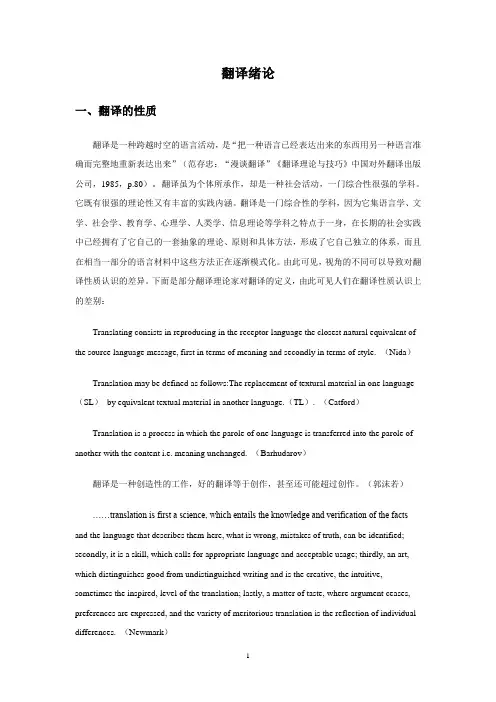
翻译绪论一、翻译的性质翻译是一种跨越时空的语言活动,是“把一种语言已经表达出来的东西用另一种语言准确而完整地重新表达出来”(范存忠:“漫谈翻译”《翻译理论与技巧》中国对外翻译出版公司,1985,p.80)。
翻译虽为个体所承作,却是一种社会活动,一门综合性很强的学科。
它既有很强的理论性又有丰富的实践内涵。
翻译是一门综合性的学科,因为它集语言学、文学、社会学、教育学、心理学、人类学、信息理论等学科之特点于一身,在长期的社会实践中已经拥有了它自己的一套抽象的理论、原则和具体方法,形成了它自己独立的体系,而且在相当一部分的语言材料中这些方法正在逐渐模式化。
由此可见,视角的不同可以导致对翻译性质认识的差异。
下面是部分翻译理论家对翻译的定义,由此可见人们在翻译性质认识上的差别:Translating consists in reproducing in the receptor language the closest natural equivalent of the source language message, first in terms of meaning and secondly in terms of style. (Nida)Translation may be defined as follows:The replacement of textural material in one language (SL)by equivalent textual material in another language.(TL). (Catford)Translation is a process in which the parole of one language is transferred into the parole of another with the content i.e. meaning unchanged. (Barhudarov)翻译是一种创造性的工作,好的翻译等于创作,甚至还可能超过创作。
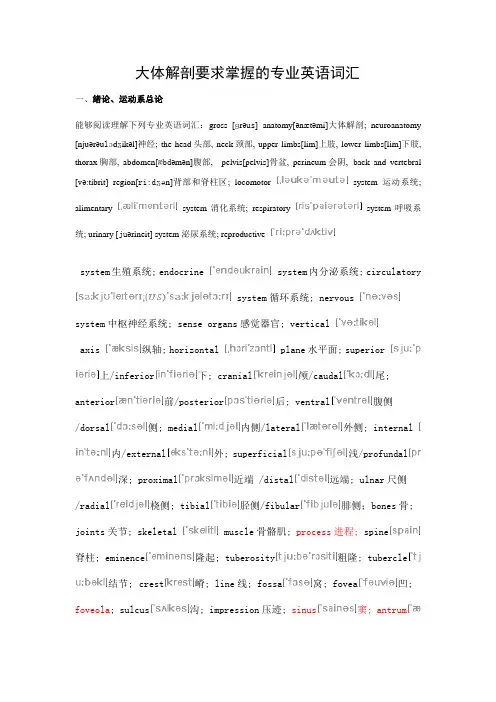
大体解剖要求掌握的专业英语词汇一、绪论、运动系总论 能够阅读理解下列专业英语词汇: gross [ɡrəus] anatomy[ənætəmi]大体解剖; neuroanatomy [njuərəulɔdʒikəl]神经; the head 头部, neck 颈部, upper limbs[lim]上肢, lower limbs[lim]下肢, thorax 胸部, abdomen[æbdəmən]腹部, pelvis[pelvis]骨盆, perineum 会阴, back and vertebral [və:tibrit] region[ri:d ʒə n] 背部和脊柱区 ; locomotor alimentary system 消化系统; respiratory system 运动系统 ; system 呼吸系统; urinary [juərineit] system 泌尿系统; reproductivesystem 生殖系统; endocrinesystem 内分泌系统; circulatory system 循环系统; nervoussystem 中枢神经系统; sense organs 感觉器官; vertical axis 纵轴; horizontal 下; cranial 前/posterior 侧; medial 内/external 深; proximal /radial 桡侧; tibial plane 水平面; superior 颅/caudal 后; ventral 内侧/lateral 外; superficial 近端 /distal 胫侧/fibular 尾; 腹侧 外侧; internal 浅/profundal 远端; ulnar 尺侧 腓侧;bones 骨;上/inferior anterior /dorsaljoints 关节; skeletal 脊柱; eminence 结节; crest foveola; sulcusmuscle 骨骼肌; process 进程; spine 隆起; tuberosity 嵴; line 线; fossa 粗隆; tubercle 窝; fovea 凹;沟; impression 压迹; sinus窦; antrum胃窦; cellules aperture capitulum 髁; synovial surface 关节面/capsule 曲/extension 展; rotation; canal管; meatus 孔; hiatus; (裂缝);孔; foramen(骨小头); condyle髁; epicondylejoints 滑膜关节; articular 囊/cavity 腔; flexion 收/abduction 旋前/supination 外翻; 止伸; adduction 回旋运动; pronation 旋后; inversion内翻/eversion 环转; origin 起点; insertioncircumduction 点; fascia bursa筋膜; retinaculum 滑膜囊/sheath; synovial 腱鞘二、内脏学、内分泌学总论能够阅读理解下列专业英语词汇:二、内脏学、内分泌学总论 alimentary pharynx tract消化道oralcavity口腔;咽; esophagus食管; stomach 胃; duodenum 空肠; vermiforml 盲肠; ascendingcolon colon 降结肠 canal十二指肠; jejunumileum阑尾回肠; cecum升结肠 transversesigmoidcolon 横结肠 descending colon 乙状结肠; rectum直肠; anal肛管; digestive glands 消化腺; salivarygland 腮腺; submandibular gland 舌下腺; liverglands 唾液腺; parotid gland 颌下腺; sublingual肝脏; pancreasbronchi胰腺; respiratory 咽 ; larynx 输尿管; urinary 喉; 主支气管 ;tract 呼吸道 ; nose 鼻子 ;; pharynx trachea lungs bladder气管 ; principal 肺; kidney 肾; ureter 尿道; testis 膀胱; urethra 输精管; ejaculatoryvesicle睾丸; ductus deferens 前列duct 射精管; prostate腺; seminal精囊; bulbourethral gland 尿道球腺; penis阴茎; scrotum 输卵管; uterusgland 垂体; pineal adrenal阴囊; ovary 子宫; vaginagland 肾上腺卵巢; uterine 阴道; pituitarybody 松果体; thyroidtubegland 甲状腺;三、脉管学、感觉器、神经系统总论能够阅读理解下列专业英语词汇: cardiovascular 血管系统; heart 心脏; artery 细血管; systemic 动脉; vein circulation 静脉; capillary 体循环; pulmonary system 淋巴系统; lymphatic /trunk 扁桃体; lymph 脾; central 脊髓; brain 大脑; peripheral /duct node 毛细淋巴管/淋巴管/ 淋巴结; thymus system 心 毛circulation 肺循环; lymphatic capillary 淋巴干/淋巴导管; tonsil 胸腺; spleen spinal cord /vesselnervous system 中枢神经系统; nervous system周围神经系统; spinal nerve 脊神经; cervical nerve 胸神经; lumbar coccygeal nervenerve 颈神经; thoracic 腰神经; sacral nerve 骶神经;nerve 尾骨神经 ; cranial nerve 嗅神经; optic nervenerve 脑神经; olfactory视神经; oculomotor nerve 面神经;nerve 动眼神经; trochlear 三 叉 神 经 ; abducent vestibulocochlear nerve 舌咽神经; vagus nerve nerve 副神经 ; hypoglossal 躯体神经 ; visceralnerve 滑车神经; trigeminal nerve nerve 展 神 经 ; facial nerve前庭蜗神经; glossopharyngeal nerve nerve 迷走神经; accessory 舌下神经 ; somaticnerve内脏神经 ; sympathetic/parasympatheticnerve 交/副交感神经; visual apparatus视觉器官; vestibulocochlear organ 前庭蜗器四、下肢 (一)下肢骨及其连结 1 hip bone 髋骨 superior 4 ischial 结节 6 pubic iliac spine 坐骨棘 2 iliac crest 髂嵴 spine 髂前上棘 5 ischial tuberosity 坐骨 3 anteriortubercle 趾骨结节7 acetabulum 9 femoral 10 greater trochanter 内/外侧踝 13 tibia 12 patella head 股骨头髋臼8femur股骨大转子 11 medial/lateral condyle髌骨 14tibial tuberosity 胫骨胫骨粗隆 15 medial/lateral malleolus16 fibula symphysis 19 obturator 骨盆 21 hip joint 髋关节 23 patellar ligament 腓骨 耻骨联合 canal 闭孔频道 20 pelvis 17 tarsal 内侧/外踝 bones 跗骨 18 pubic22 knee joint 膝关节 髌韧带24 fibular/tibial collateral 骨韧带 25 anterior ligament /posterior 前/后交叉韧带ligament腓骨/胫cruciate26 medial/lateral meniscus 27 ankle foramen 29 lesser terminal joint 踝关 节 更大坐骨神经孔 sciatic line 终端线内侧/外侧半月板 28 greater sciaticforamen较低坐骨神经孔30(二)下肢前面浅层和股前内侧区 能够阅读理解下列专业英语词汇:great/small saphenous uperficial inguinal lateral 皮神经; fascia 股四头肌; adductor 收肌腱裂孔; lacuna vasorum femoral canal adductor femoral saphenous lata 阔筋膜; iliopsoas brevis iliotibial tract musculorum 血管腔隙; 股管 ; canal 收肌管 lymphvein大/小隐静脉nodes 浅腹股沟淋巴结; cutaneous nerve 隐神经; quadriceps 髂; 短收肌; adductor hiatus femoris nerve 股外侧髂胫束; 肌腔隙 lacuna 股鞘 股三角;femoralsheathfemoral triangle三)小腿前外侧区和足背 能够阅读理解下列专业英语词汇:retinaculum tibial artery 韧带; anterior胫前动脉 ; deep/superficial peronealartery of foot 背动脉足; common peronealnerve 深/腓浅神经; dorsal nerve 腓总神经;;;;(四)下肢后面浅层,臀区和股后区 能够阅读理解下列专业英语词汇: sural maximus nerve 腓肠神经; gluteus臀大肌; piriformis/infrapiriform foramen梨状肌; suprapiriform———— ; superior artery /nerve 臀上 /臀下动/inferiorgluteal脉/神经; sciaticinternal pudendal arterynerve 坐骨神经; pudendalnerve 阴部神经; muscle 腿筋肌内部阴部动脉; hamstring肉(五)腘窝和小腿后区 能够阅读理解下列专业英语词汇: tibial artery 腘动脉; triceps surae nerve 胫神经; popliteal小腿三头; gastrocnemiustibial腓肠肌; soleusartery 胫后动脉; tibialis anterior longus 屈指长肌; flexor fossa比目鱼肌; posterior 胫前; flexor digitorumhallucis longus 屈拇长肌;popliteal canal 踝管.腘窝;malleolar六、上肢 (一)上肢骨及其连结 1 clavicle 锁骨 肩峰 4 coracoid 肩胛切迹 6 humerus 8 radius 9 radial 骨 11 carpal 12 scaphoid 14 shoulder 半径 tuberosity bones 腕骨 bone 手舟骨 joint肩关节 13 pisiform bone 豌豆骨 径向结节 10 ulna 尺 肱骨 7 greater tubercle 更大结节 process 喙突 5 scapular notch 2 scapula 肩胛骨 3 acromion15 elbow尺关节joint肘关节16 humeroulnarjoint 肱17 humeroradial joint肱桡关节18 proximalradioulnarjoint桡尺近侧关节 19 wrist 21 anatomical 部和外科颈 joint 腕关节 20 coracoacromial arch 喙拱 neck and surgical neck解剖颈(二)臂、前臂前面浅层,胸前外侧区和腋窝 能够阅读理解下列专业英语词汇:breast 乳房; pectoralis axillary 腋静脉; thoracoacromial artery 胸肩峰动脉; lateral artery 胸外侧动脉 ; subscapular posterior 后动脉; brachial pectoral humeral plexus circumflex 臂丛;media nerve 胸 内 侧 神 经 ; major 胸大肌; thoracic artery 肩胛下动脉 ; artery 旋肱 l/lateral musculocutaneous nerve 正中神经 ; vein 头静脉 ;[ˌmʌskjʊləʊkjuːˈteɪnɪəs]radial basilicnerve 肌皮神经 ; mediannerve 桡神经 ; ulnar nerve 尺神经 ; cephalic vein 贵要静脉; median ligament of breast 锁胸筋膜;axillarycubital vein 肘正中静脉;suspensory /Cooper ’s fossa ligament 腋乳房悬韧带;clavipectoral fascia 窝;axillary sheath 腋鞘.(三)臂前区,肘窝和前臂前区 biceps brachii 肱二头肌; brachial artery 肱动脉; 肱桡肌 ; fossaradial pronator 肘窝.artery 桡动脉; ulnar artery 尺动脉; teresbrachioradialis旋前圆肌; cubital(四)手掌 palmar aponeurosis /deep palmar space 鱼际空隙; canal. middle palmar 腕管 arch 掌腱膜; superficial肤浅 / 掌深弓 ; thenar space 掌中间隙; carpal(五)背部浅层和肩胛区 trapezius accessory 三 边空 ; latissimus dorsi 掌腱膜; nerve 副神经; trilateral quadrilateral 肌腱袖 foramen deltoid foramen 四边孔 三角肌;musculotendinous cuff(六)臂、前臂后区和手背 triceps snuff brachii box. 鼻烟窝i 肱三头肌;radialnerve 桡神经;。
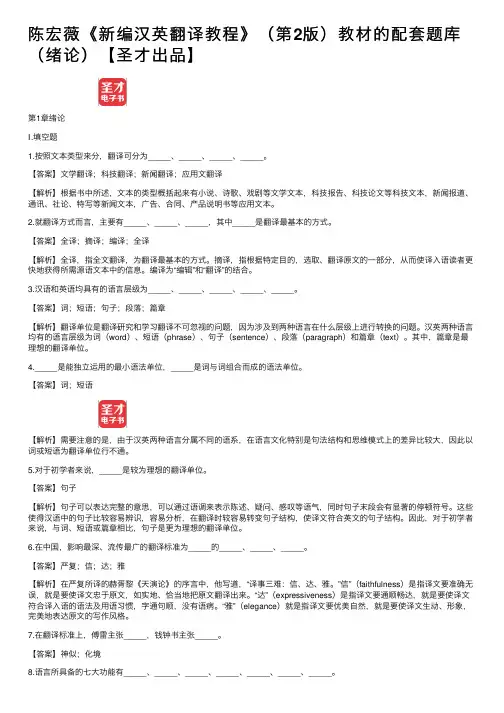
陈宏薇《新编汉英翻译教程》(第2版)教材的配套题库(绪论)【圣才出品】第1章绪论Ⅰ.填空题1.按照⽂本类型来分,翻译可分为_____、_____、_____、_____。
【答案】⽂学翻译;科技翻译;新闻翻译;应⽤⽂翻译【解析】根据书中所述,⽂本的类型概括起来有⼩说、诗歌、戏剧等⽂学⽂本,科技报告、科技论⽂等科技⽂本,新闻报道、通讯、社论、特写等新闻⽂本,⼴告、合同、产品说明书等应⽤⽂本。
2.就翻译⽅式⽽⾔,主要有_____、_____、_____,其中_____是翻译最基本的⽅式。
【答案】全译;摘译;编译;全译【解析】全译,指全⽂翻译,为翻译最基本的⽅式。
摘译,指根据特定⽬的,选取、翻译原⽂的⼀部分,从⽽使译⼊语读者更快地获得所需源语⽂本中的信息。
编译为“编辑”和“翻译”的结合。
3.汉语和英语均具有的语⾔层级为_____、_____、_____、_____、_____。
【答案】词;短语;句⼦;段落;篇章【解析】翻译单位是翻译研究和学习翻译不可忽视的问题,因为涉及到两种语⾔在什么层级上进⾏转换的问题。
汉英两种语⾔均有的语⾔层级为词(word)、短语(phrase)、句⼦(sentence)、段落(paragraph)和篇章(text)。
其中,篇章是最理想的翻译单位。
4._____是能独⽴运⽤的最⼩语法单位,_____是词与词组合⽽成的语法单位。
【答案】词;短语【解析】需要注意的是,由于汉英两种语⾔分属不同的语系,在语⾔⽂化特别是句法结构和思维模式上的差异⽐较⼤,因此以词或短语为翻译单位⾏不通。
5.对于初学者来说,_____是较为理想的翻译单位。
【答案】句⼦【解析】句⼦可以表达完整的意思,可以通过语调来表⽰陈述、疑问、感叹等语⽓,同时句⼦末段会有显著的停顿符号。
这些使得汉语中的句⼦⽐较容易辨识,容易分析,在翻译时较容易转变句⼦结构,使译⽂符合英⽂的句⼦结构。
因此,对于初学者来说,与词、短语或篇章相⽐,句⼦是更为理想的翻译单位。
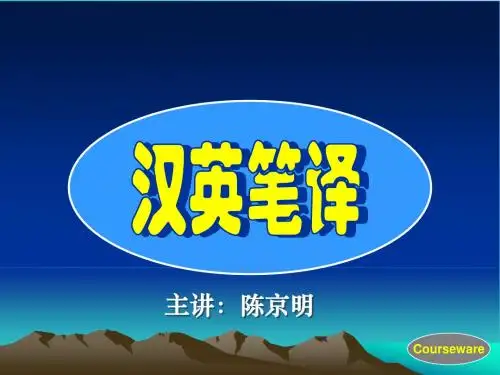
第1章绪论1.1 复习笔记一、翻译的性质与类型1. 翻译的意义翻译是将一种语言文化承载的意义转换到另一种语言文化中的跨语言、跨文化的交际活动。
翻译的本质是释义,是意义的转换。
翻译活动涉及诸多因素:译者(translator)、作者(author)、原文(source text)、原文读者(source-text readers)、译文(target text/translated text/target version)、译文读者(target-text readers)等。
2. 翻译的类型①就文本而言,翻译可分为文学翻译、科技翻译和应用文翻译。
②就方式而言,主要有全译、摘译和编译。
二、汉英翻译的单位翻译单位可以决定在什么层级上实现翻译的标准。
汉语和英语的语言层级均有词(word)、短语(phrase)、句子(sentence)、段落(paragraph)和篇章(text)。
对初学者来说,句子是较为理想的翻译单位。
但是汉语句子只是语义相对完整的一个单位,它与相邻句子之间必然存在语义上的关联,所以不可孤立地翻译句子而忽视句子之间的关系。
三、汉英翻译的标准1. 中国的翻译标准在中国,严复的“信、达、雅”(faithfulness, expressiveness and elegance)是影响最深、流传最广的翻译标准。
该三字标准最早出现于佛经翻译家支谦的《法句经序》中。
文学翻译家黄龙先生对严复提出的翻译标准倍加欣赏,并赋予“信、达、雅”新的内涵和生命,其标准适用于文学翻译。
另一位翻译家刘重德先生在严复的基础上,提出了“信达切”(faithfulness, expressiveness and closeness)的翻译标准。
“信”指信于原文内容(to be faithful to the content of the original);“达”指具备原文一样的表现力(to be as expressive as the original);“切”指尽可能切近原文风格(to be as close to the original style as possible)。